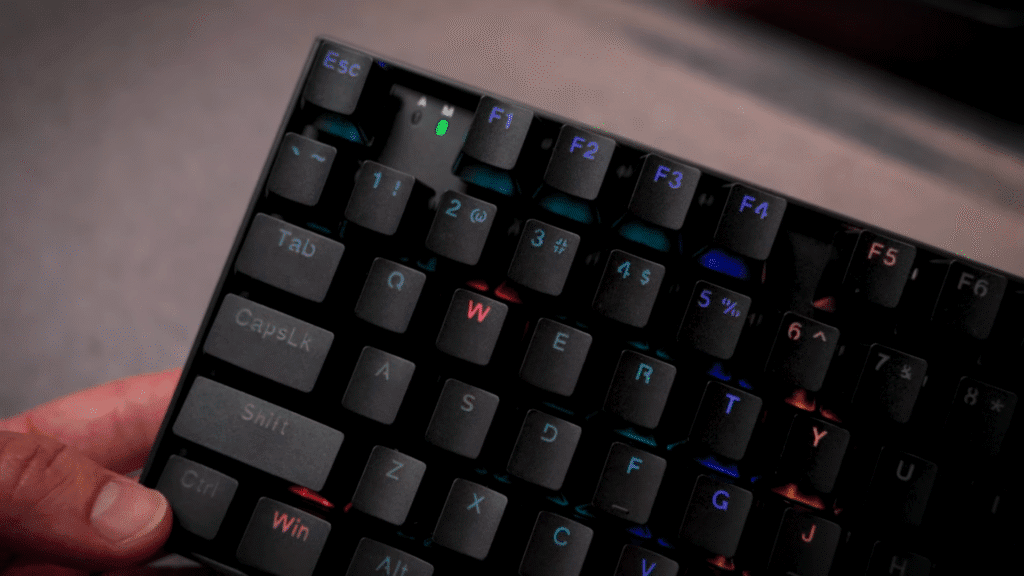Let’s dive into the Redragon K736 PRO. The magnetic switch wave is hitting hard, and Redragon’s stepping up with a really interesting contender here. What you’re getting is that sweet Hall Effect tech – adjustable actuation points and rapid trigger – which can seriously change how responsive your inputs feel, especially in fast-paced games. They’ve packed this into a unique 90% layout, so you keep the numpad without the bulk of a full-size board, a smart compromise for many setups.
Considering all this tech – the magnetic switches, rapid trigger, wireless options, PBT keycaps, and that practical 90% design – the price point is honestly quite aggressive. Seeing it listed on Amazon for $74.99 makes it a really compelling option for anyone wanting to dip their toes into magnetic switch technology without emptying their wallet. It feels like Redragon knows exactly what features gamers are looking for and has packaged them smartly in the K736 PRO. It definitely warrants a closer look.
Overview – What will you get?
The core appeal lies in those Hall Effect magnetic switches. Instead of a physical contact point, they use magnets and sensors to detect key presses. This allows for some cool tricks, primarily adjustable actuation points and rapid trigger functionality.
With the K736 PRO, you can actually customize how far down you need to press a key for it to register. Using Redragon’s software, you can set this anywhere from a super-sensitive short distance to a deeper press. This is huge for gaming – you can tailor it for lightning-fast reactions in FPS titles or set it deeper to avoid accidental presses during intense moments or while typing. The included Redragon linear magnetic switches feel pretty smooth out of the box, with the magnet placed centrally. It’s nice that they’re compatible with other central-magnet switches like certain Gateron or TTC models, giving you future upgrade paths if you want a different feel or sound profile, though the stock ones are perfectly capable.
Then there’s the rapid trigger feature. This allows the switch to reset the instant you start lifting your finger, rather than waiting for it to pass a fixed reset point like traditional mechanical switches. For gamers, this means you can perform actions like strafing or stutter-stepping much more quickly and precisely because the key is ready for the next press almost immediately after you begin releasing it. The software even includes presets like ‘Standard’, ‘Sensitive’, and ‘Gaming’ to quickly toggle between different actuation and rapid trigger settings, plus a ‘Custom’ mode for fine-tuning. Tests, like the wall-spray example in Valorant, clearly show how the ‘Gaming’ preset tightens up movement control significantly compared to standard settings.
The physical design of the K736 PRO is also quite specific. It uses a 90% layout. Think of it as a tenkeyless (TKL) board that squishes a numpad onto the right side, eliminating most of the navigational cluster (like dedicated Home, End, PgUp, PgDn keys, though these are often accessible via an Fn layer) to save desk space. It’s a smart compromise for people who really need that numpad for work, productivity, or certain game keybinds but still want something more compact than a full-size behemoth. Everything feels tightly packed, maximizing function within a smaller footprint.
Build-wise, it feels solid. You get doubleshot PBT keycaps, which are durable and resist shine better than standard ABS caps. The legends are shine-through, allowing the RGB lighting to illuminate them clearly. Speaking of RGB, it’s north-facing, meaning the LED is positioned at the top of the switch. This makes top legends bright but means side-printed or “pudding” keycaps won’t light up as effectively. Inside, there’s a metal switch plate for rigidity and some dampening material between the PCB and the plate to help reduce unwanted pinging noises, contributing to a reasonably pleasant typing sound profile for a budget board. Adjustable feet on the back let you tweak the typing angle.
Connectivity is another strong point. You get three ways to connect: standard wired USB-C (the port is on the side, and it comes with a convenient L-shaped cable), low-latency 2.4GHz wireless using an included USB dongle (which cleverly stores in a dedicated slot on the keyboard’s underside), and Bluetooth. The Bluetooth mode supports pairing with up to three different devices, and you can switch between them easily using Fn key combinations (Fn+1, Fn+2, Fn+3). This makes it super handy if you jump between a desktop, laptop, or even a tablet or phone. A physical switch on the back toggles between 2.4GHz, Off/Wired, and Bluetooth modes.
Now, about that polling rate. The product page often mentions an 8K polling rate for super-fast input reporting, especially beneficial in competitive gaming. However, testing often reveals it running at a standard 1K polling rate out of the box. The software, at least in initial versions, doesn’t seem to offer an obvious toggle to switch to 8K. This might require a specific firmware update or driver version that isn’t immediately apparent. It’s a point of confusion worth noting; while 1K is perfectly fine for almost everyone, the advertised 8K capability seems harder to access than expected. Clarification from Redragon or a future update would be helpful here.
Conclusion
Despite the polling rate query, the combination of adjustable magnetic switches with rapid trigger, versatile wireless connectivity, and that practical 90% layout makes the K736 PRO a compelling option. The PBT keycaps and decent internal dampening are nice touches at this price. You’re getting access to cutting-edge switch technology without the premium cost often associated with it, packaged in a thoughtful design that balances gaming needs with everyday usability thanks to the included numpad. The customization available through the software, particularly for the switch behavior, really lets users dial it into their specific preferences for different games or tasks.

